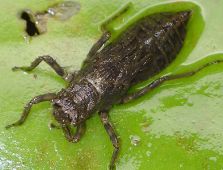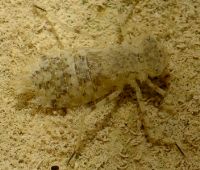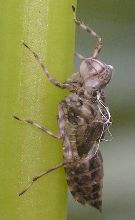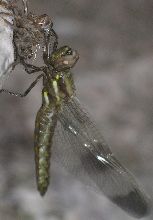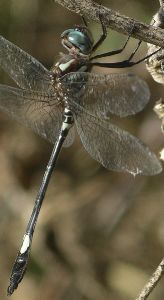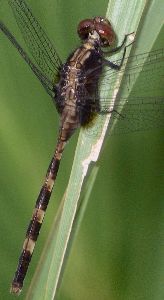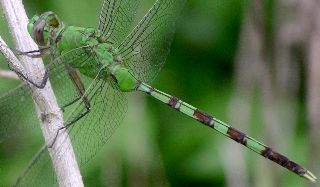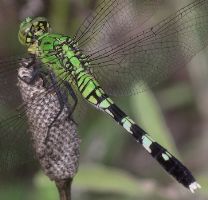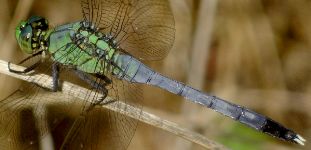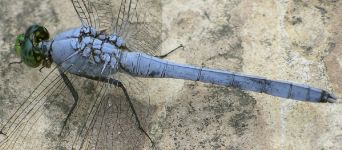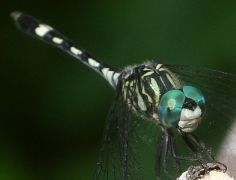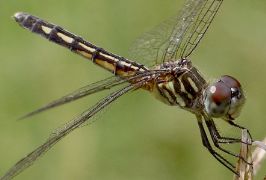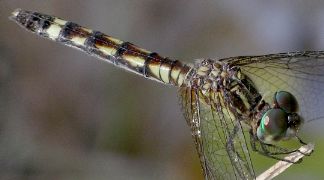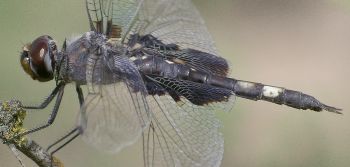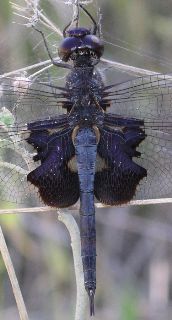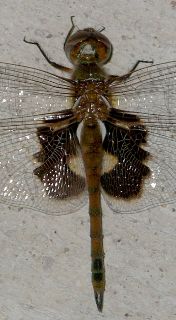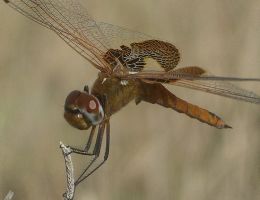
| Libellulidae ~ Skimmers |
|
This is the biggest family of dragonflies, with many large and colorful species. Besides a good number of species, there are often numerous individuals of several types around any body of water. While the larvae are not often casually encountered, as they are aquatic, they are still the most commonly seen of any odonate group. Most skimmers live in still water instead of flowing, so they are usually seen around ponds, from tiny garden pools to lakes.
Unless a person is actually hunting the larvae in water, the immature insects are most likely to be seen when they emerge to molt into adulthood. They climb out of the water and cling to vegetation or rocks along the shore. Not only are the larvae found, but so are their shed skins, which are called exuviae. Occasionally, it is even possible to witness the molting process, or find a fresh adult still hanging around near its exuviae.
Most skimmers are rather robust, with fairly thick abdomens. However, some species are much more slender. Probably the species most easily misidentified at the family level is the Pale-faced Clubskimmer (Brechmorhoga mendax). This libellulid has a slender abdomen, swollen at the base, which is widely clubbed near the tip in males, making it look like it belongs in the Gomphidae. The females do not have the club, and the eyes of both touch at the top of the head, unlike the separation on clubtails. The eyes are light blue and the abdomen sports a pair of large pale bluish spots near the tail end. I've only seen this species once.
An uncommon species in our area that I have not seen is the Pin-tailed Pondhawk (Erythemis plebeja). I have observed this species in Florida, which is where the accompanying photo was taken. The identifying characteristics are a long thin abdomen and black thorax, as well as small black patches at the bases of the wings, the largest being on the hind wings. The female is black only on the sides of the thorax. The abdomen has broad tan and black bands.
A slightly more common member of the same genus is the Great Pondhawk (Erythemis vesiculosa). For some reason, I've never photographed a female, but the males are quite distinctive. They are all green, with a long and slender brown-banded abdomen, swollen at the base. The thorax is solid green with no stripes or markings. One other species may be easily confused with the Great Pondhawk, and that is the Eastern Pondhawk (Erythemis simplicicollis). The female of this species is also brilliant green, with a black-banded abdomen. However, the Eastern Pondhawk female usually has more white on the abdomen, and always has a white tip. The shape is shorter and more squat, and the whole insect is a bit smaller. Of course, the biggest difference between the two is the sex, evident from the tip of the abdomen as well as the underside of the base. The female Eastern Pondhawk is highly variable, although most that I've seen look like the one just described. However, the other photo shown here is so different that I find it hard to believe it is the same species, as it completely lacks the distinct black markings and the abdomen is quite wide. Dragonflies can spread and flatten their abdomen to some extent when they want to soak up some sun.
The Eastern Pondhawk is by far the most common species in that genus, and is often present along with several other species at ponds. Males are easy to identify, as they are a chalky blue, with a white tip on their abdomen. Very young males have a green thorax, which makes for a more colorful specimen, but the green soon fades beneath the blue pruinescence. The face remains bright green, though. Another chalky blue male dragonfly is the Blue Dasher (Pachydiplax longipennis). They sometimes fly right along with the Eastern Pondhawk, inviting comparison between the species. The Blue Dasher is smaller but often more aggressive, and seems to like taking over prime perches from the Eastern Pondhawk. When seen close, it is easy to identify the Blue Dasher, which has a white face, striped yellowish and dark thorax, and brilliant green eyes. The abdomen is blue, but the tip is often very black and the base has yellow at the sides. The females and young males of the Blue Dasher are patterned in dark brown and pale yellow or greenish. This exceedingly common dragonfly is often present at very small garden ponds. The females and young males of course have different genitalia, but mature females can also be recognized by their bright blue eyes. When both males and females are very young, their eyes are brown instead.
Because the Blue Dasher is so common, it is easy to overlook a similar species, the Thornbush Dasher (Micrathyria hagenii). Males and females of this species superficially resemble female Blue Dashers, as they are strongly patterned in light and black. However, the easiest way to recognize the Thornbush Dasher is by the extra large light spots near the tip of the abdomen, which connect together to create a large white patch on the male and almost connect on the female. These same spots are relatively small on Blue Dashers. Males can also be distinguished by their more slender abdomen. Both sexes have blue eyes, but the male's are more intense. There are actually some skimmers that cannot easily be confused with any others. The Black Saddlebags (Tramea lacerata) is one. These large dragonflies can often even be identified in flight. Both genders have large black markings at the base of the wings: the "saddlebags." The female tends to be more brown while the male turns bluish black.
One other saddlebags species is common here: the Red Saddlebags (Tramea onusta). The thorax color is brown; the abdomen color of females and immature males is golden brown while that of mature males is red. The saddlebag markings on the wings are matching colors, but they may vary in size a bit, sometimes extending all the way to the rear margin of the wing and sometimes stopping short. If the wing markings are not enough for identification, both male and female Red Saddlebags have black marks on the tops of the two abdominal segments just before the tip. |
![]()
